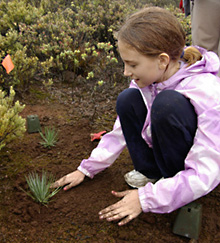 |
| Photo by G. Brad Lewis | | Volunteers have planted more than ten thousand silversword seedlings on Mauna Loa since 2000. Nearly all survive. |
 |
It's a Race to Rescue and Restore Balance
Most visitors to Hawai`i Volcanoes National Park are enchanted by its active volcanic personality and its misty cloak of rainforest. Many never realize that its underlying treasure of native plants, animals and habitats faces an ecological crisis.
Species that have survived for millennia face unabated threats from a host of invaders introduced by humans over the past 200 years, as well as declining habitat outside the Park. With these threats even lava flows, nature’s way of restoring habitats, become a threat to remnant patches of native habitat. Feral pigs, goats, and mouflon sheep; invasive plants; feral cats and rats, mongoose, ants, wasps, and mosquitoes, these invaders are all taking a tremendous toll on native plants and animals. Sadly, Within Hawai’i Volcanoes National Park live 23 species of endangered vascular plants (6% of the flora) and 6 of 15 endangered native birds. Hawai`i is the leading state for both extinctions and federally listed endangered species in the United States.
Unfortunately, setting aside protected natural areas is not enough. The race to control invasives and restore native ecosystems, as well as to recover the Park’s endangered plants and animals, requires an aggressive commitment of time and funds. The strategy focuses first on removal of alien ungulates such as mouflon sheep, planting of common natives in Park landscapes that have been disturbed by ungulates or wildfire, control of invasive species and planting of endangered and rare plants. Four endangered species, the nene, Hawaiian petrel, hawksbill turtle and Ka’u silversword are targeted for full recovery by the National Park Service staff and its partners, who are aggressively engaged in restoring habitat, guarding nest sites, monitoring threats and population impacts, and removing alien wildlife.
|






